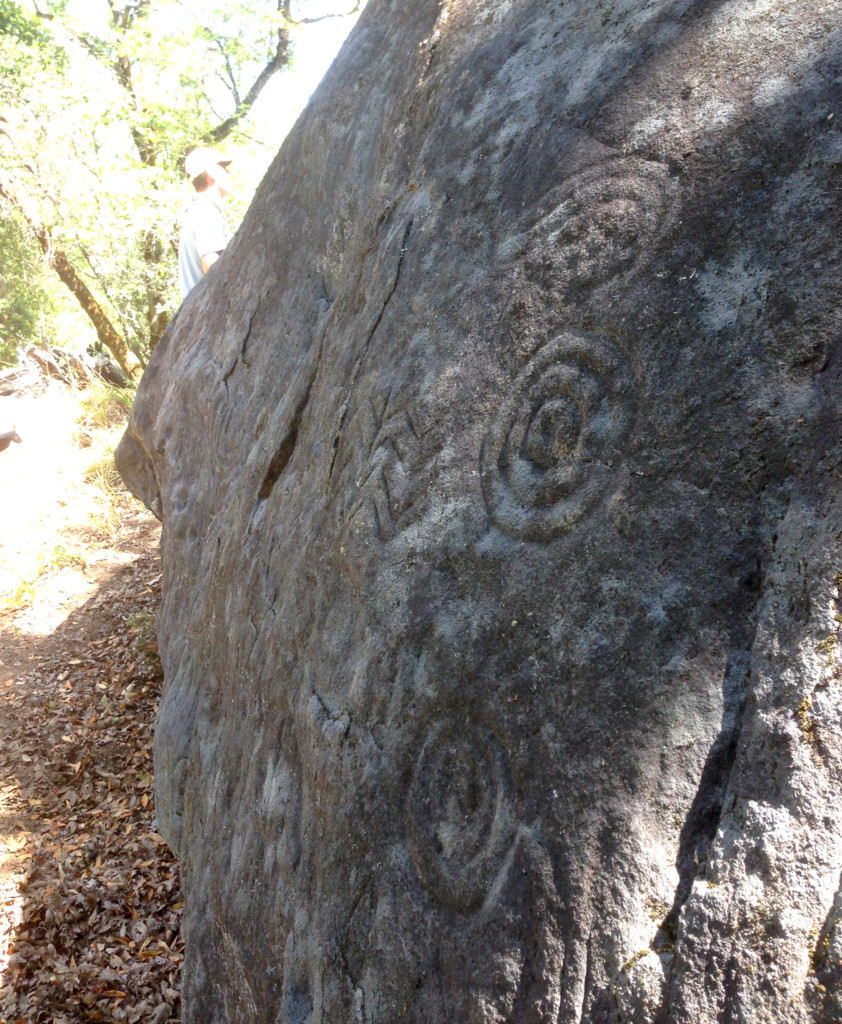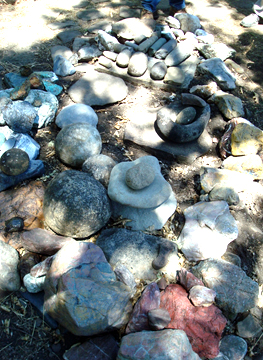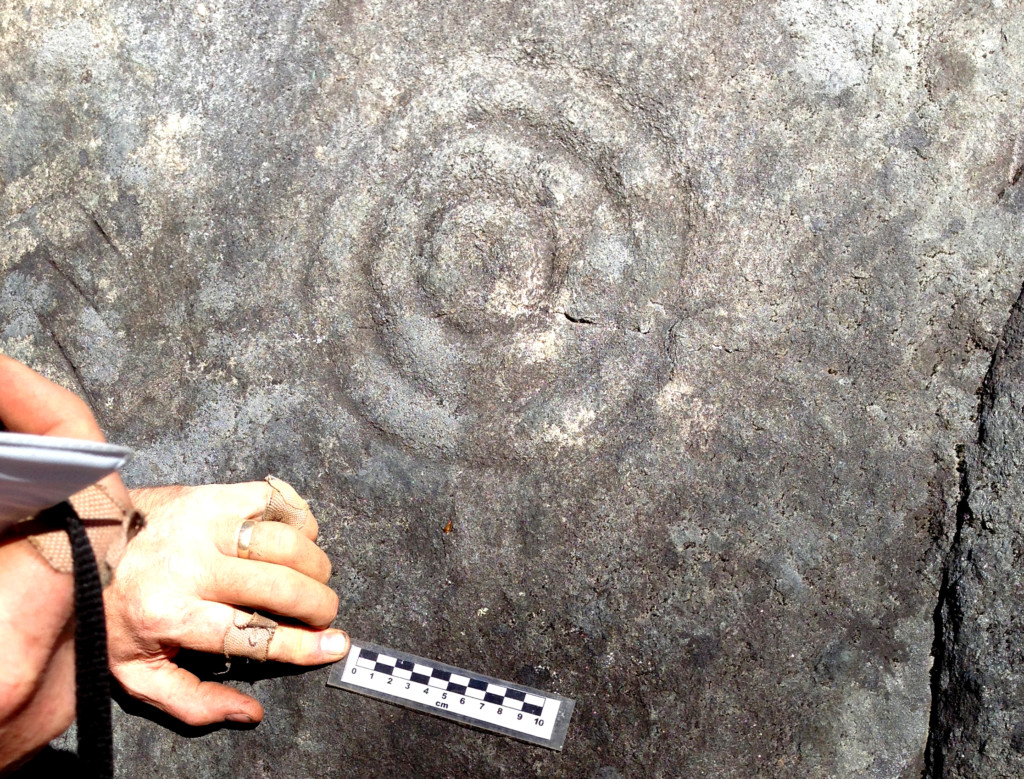The acquisition and preservation of this unique California property continues the vision and work of its late owner, Dahinda Meda.
Despite limitations associated with the pandemic and the subsequent shutdowns, The Archaeological Conservancy recently completed two acquisitions in the Western Region. Both properties required lengthy planning and negotiations that spanned over years. Each site offers important information about the prehistory of California and the Native Americans who occupied the area hundreds and thousands of years ago.
In this post, The Conservancy’s Western Regional Director, Cory Wilkins, shares details about Terrarium – a 360-acre parcel located outside of Ukiah, California. This site has a unique story both past and present. The property contains multiple pit houses, middens, and rock art panels, as well as lithic and stone tools associated with the Central Pomo tribe dating back to at least 500 B.C. and possibly as early as the Archaic.
The Acquisition of Terrarium in Ukiah, California
By Cory D. Wilkins, Western Region Director
Terrarium was named by its very colorful owner, Dahinda Meda. Dahinda was passionate about the preservation of all things on his property, but especially protective of the cultural resources found there. The land within Terrarium lies in the ethnographic territory of the Central Pomo. At historic contact these were lands claimed by the Lema tribelet of the Central Pomo, whose principal village was located along McNab Creek in McNab Valley.
Dahinda Meda’s Vision

Dahinda Meda, the late owner of Terrarium
As the story goes, Dahinda dreamed of the place from the time he was a child. Sometime before purchasing his first 40-acre Terrarium parcel in 1975, Dahinda was visiting a friend’s house in the vicinity of Feliz Creek. Dahinda believed that he was called to hike up the creek, where he was led to a very large boulder laden with petroglyphs. That was it. Dahinda found his Terrarium, so named for the layout of the property. Terrarium sits in a large, natural bowl at the confluence of three creeks. The bowl is ripe with wildlife, vegetation, water, and archaeology. This was Dahinda’s most spiritual place. The place Dahinda protected and nurtured for the remainder of his life. Sadly, Dahinda was lost to this world in April of 2016, but his desire to protect his property would live on.
In 2011,Dahinda and his wife, Norma Grier, met with The Archaeological Conservancy to discuss their vision for permanently protecting the property. The Conservancy’s President, Mark Michel, and I spent several years working through the terms of the archaeological conservation easement that would protect the property in perpetuity. This was important because the easement protections ensure that Dahinda’s goals for Terrarium legally remain with the property.
Archaeology at Terrarium
 The cultural resources at Terrarium have been visited and recorded several times. First in 1972, vocational archaeologist John Wright noted nine house pits, a large midden mound, and many lithic points and tools. In 1974 and 1976, recordings by Pamela Roberts, Scott Patterson, and Jonathon Leonard focused on the large petroglyph boulder covered with cupules, grooves, concentric circles, and grinding marks. In 2010, California Department of Forestry and Fire Protection archaeologist Dan Foster made a more extensive recording of Terrarium. In 2012, The Archaeological Conservancy conducted its initial field visit with Dr. Greg White. During the visit, White noted four archaeological sites, including two that had been previously recorded, and two new discoveries. His finding included several areas with high- to moderate-density lithic scatters of several different types of chert and obsidian, fire-cracked rock, bifaces, middens, stone tools, rock cupules, and large petroglyph boulders. Of his findings, White stated, “Assemblages of this character and sites with this stage of soil development and weathering are typical of the Middle Archaic, dating sometime between 7,000–2,500 years old.”
The cultural resources at Terrarium have been visited and recorded several times. First in 1972, vocational archaeologist John Wright noted nine house pits, a large midden mound, and many lithic points and tools. In 1974 and 1976, recordings by Pamela Roberts, Scott Patterson, and Jonathon Leonard focused on the large petroglyph boulder covered with cupules, grooves, concentric circles, and grinding marks. In 2010, California Department of Forestry and Fire Protection archaeologist Dan Foster made a more extensive recording of Terrarium. In 2012, The Archaeological Conservancy conducted its initial field visit with Dr. Greg White. During the visit, White noted four archaeological sites, including two that had been previously recorded, and two new discoveries. His finding included several areas with high- to moderate-density lithic scatters of several different types of chert and obsidian, fire-cracked rock, bifaces, middens, stone tools, rock cupules, and large petroglyph boulders. Of his findings, White stated, “Assemblages of this character and sites with this stage of soil development and weathering are typical of the Middle Archaic, dating sometime between 7,000–2,500 years old.”
The archaeology at Terrarium is unique according to scholars who have conducted research on the property over the years. Dan Foster noted during his research in 1986 that “this style of petroglyph is very uncommon in Mendocino County.” In 2012, Dr. Greg White stated that investigations at the site have “the potential to yield new and important insights into the proto-Pomo expansion of 550 B.C.” White further iterated that “this migration event has the potential to rank among the more distinct and well-defined prehistoric cultural migration phenomena of the Far West.” In 2015, Sherrie Smith-Ferri, Ph.D., a member of the Dry Creek Band of Pomo Indians and Director of the Grace Hudson Museum reported, “I know of no other such site, in northern California, whose future is being safeguarded.”
 During his lifetime, Dahinda Meda’s passion for his land resulted in the protection of the unique and important archaeological resources on his land; however, it is his lifelong vision that will protect these treasures in perpetuity. The Archaeological Conservancy is proud to carry his vision forward into the future.
During his lifetime, Dahinda Meda’s passion for his land resulted in the protection of the unique and important archaeological resources on his land; however, it is his lifelong vision that will protect these treasures in perpetuity. The Archaeological Conservancy is proud to carry his vision forward into the future.
The Archaeological Conservancy (2020)




